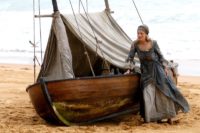Yet another case of a disappearing journal:
Following the mutiny on the Bounty, after Bligh returned safely to England, and before Bligh received his commission to the Providence, Governor Phillip in Sydney Cove was seething. He had discovered that eleven convicts and settlers had absconded in his fishing boat, a ship’s gig – an open boat or cutter, considerably lighter and smaller than the Bounty’s launch – propelled with six oars and a sail. On 28 March 1791, just before midnight, eight men plus one woman and her two children fled from Sydney Cove and made their way north to Torres Strait then west across the Arafura Sea to Timor. After a 67-day adventurous voyage, they arrived in Timor on 5 June. Apart from two muskets, they were no better equipped than Bligh was in his launch. Their voyage covered only slightly less distance than the launch, but unlike Bligh, they starting out in cold boisterous weather and, worse still, they had to contend with contrary winds and constant exposure to hostile natives. The leader of the escapees was William Bryant: he and his wife Mary Bryant were among the first couples to be married in Phillip’s new settlement; they had two children, a girl and a boy. Notwithstanding their hardship all eleven arrived at Kupang in reasonable health where they masqueraded as ill-fated castaways off an English brig.
The little Dutch settlement at Kupang owed much of its prosperity to the sandalwood trade. It was a remote place yet comforting to wayfarers for things like Birmingham commodities, even Wedgewood stoneware, could be purchased from the village shops. Trusting in the rather eloquent story that the deserters told, Kupang’s kindhearted governor, Mynheer Wanjon (or Vanion), cared for them till their deception was discovered shortly after the arrival of four more boatloads of shipwrecked sailors. Wrecked on 28 August 1791, the first survivors of the Pandora arrived at Kupang on 17 September 1791. Two weeks later Bligh arrived in the Providence. Apart from learning of the wreck of the Pandora, Bligh also learnt of the eleven convicts who had absconded from Sydney Cove. One of the deserters kept a journal entitled ‘Remarks on a Voyage from Sydney Cove, New South Wales, to Timor’. The journal had found its way to Governor Wanjon who had entrusted it to his friend Bligh. This original account of their adventures has unfortunately been lost to posterity. Bligh said he had been ‘too ill at this time to copy the journal. I however employed a person about it, but he did not get a fourth part through it’. Bligh apparently had had a sudden return of his migraine headaches, yet his ailment did not preclude him from writing prodigiously in his own journal. Ida Lee says, ‘It is to be regretted that Captain Bligh did not succeed in obtaining a copy of this journal.’
During the early part of Bryant’s voyage, the intrepid eleven had come across lumps of black coal then a whole seam of coal. Later in London, information received about this may have led to the discovery of the now famous Newcastle coal deposits. It is unfortunate that the excitement generated by the discovery of coal had overshadowed the remarkable voyage by Bryant, his 25-year-old wife and the rest of the crew. It is not surprising that Bligh, who had already overcapitalized on his launch voyage, had developed a headache at being so poetically eclipsed by a woman and her children. Such epic feats were usually reserved for the worldly club of patriarchal adventurers. Mary Bryant took the wind right out of Bligh’s sails. Captain Edwards of the Pandora also took the shine off Bligh’s open boat drama averaging a whopping 25 survivors per ship’s boat. Little wonder Bligh was struck with such a bad headache. Imagine the severity of his headaches had he known that in 1897 two men would leave New York and row an 18 foot open jollyboat right across the stormy north Atlantic; then on 10 January 1933, the New York Times announced how Fred Rebell sailed an 18-foot open skiff single-handed all the way from Sydney across the Pacific to Los Angeles. These and many other adventurers like them had all embarked intentionally – they were neither shipwrecked nor fleeing from persecution, and for that matter, as it will be seen, neither was Bligh in his well-equipped launch.
That Bligh made no real effort to obtain or copy out Bryant’s journal, aptly demonstrates the strong resentment he felt towards the convicts sea-going achievements. Possibly Bligh worried that if Bryant’s journal were to be published, his struggle to maintain public sympathy would in some way be diminished. It was typical of Bligh that he left no trace of particular logs or journals that didn’t fit in with his preferred version of events; as has been suggested, Bligh had his own devious ways of dealing with manuscripts he thought were contrary to his longer-term interests. Governor Phillip also considered Bryant’s achievements were against his interest. After hearing of Bligh’s voyage in the launch, then discovering how easy it was for convicts to escape in a cockle-sized cutter, he directed that anyone contemplating building a boat, that boat was to be of stated dimensions not exceeding 14-feet from stem to stern. As far as Phillip was concerned, anything over 14-feet long was sufficiently seaworthy and a potential vehicle for his convicts to abscond in.
[Picture: a scene from The Incredible Journey of Mary Bryant.
2005 Mini-Series
Granada Television]



Administrator’s Note:
While articles are being added to this newly developed News section, public commentary is switched off. If you wish to comment please proceed to Facebook: HMS Bounty – Conspiracy on the Bounty where you will locate an identical or verisimilar article.
See: https://web.facebook.com/HMS-Bounty-Conspiracy-on-the-Bounty-328458497262836/